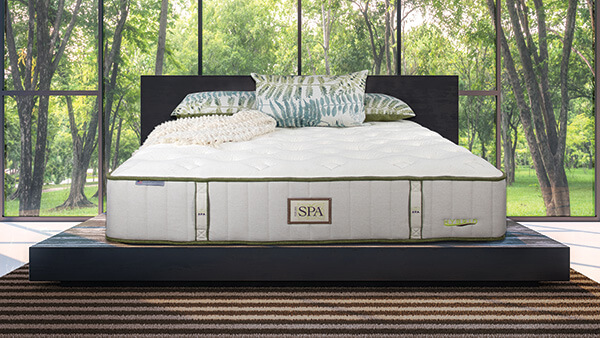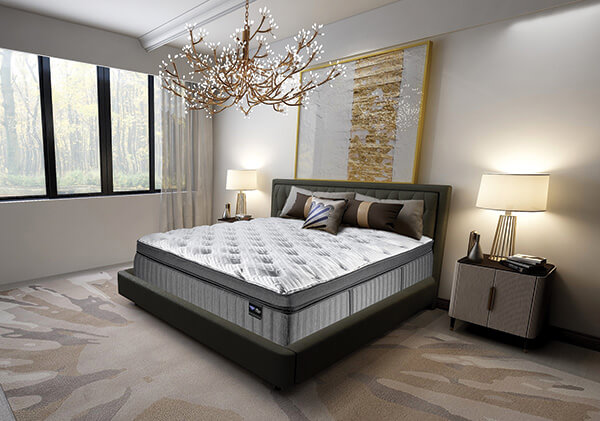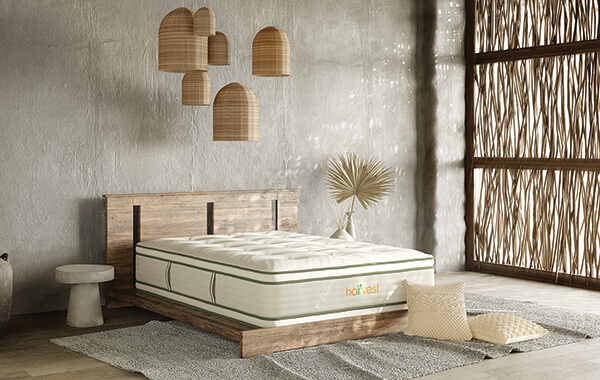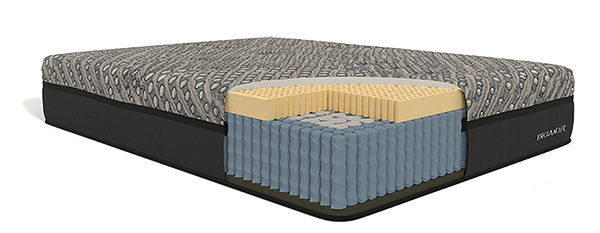Hybrids combine feature-filled foams and fabric-encased springs to give consumers the best of both worlds.
They aren’t as ubiquitous as Priuses in some parking lots, but consumers are increasingly test-
driving hybrid mattresses and finding a perfect spot for them in their bedrooms.
Marketing buzz — backed up by mattresses that provide real benefits to consumers — is helping to accelerate sales, says Nick Bates, president of Spring Air International, a licensing group based in Woburn, Massachusetts.
“Retailers and consumers gravitate to the term ‘hybrid,’ and consumers are walking into stores now asking to see hybrid mattresses in much the same way they used to walk into stores requesting to see pillow-tops,” Bates says. “It’s a marketing buzzword that sounds contemporary and techy, and it has caught on. Shoppers’ perception is that hybrid mattresses are the latest and greatest, and we know that at retail, new always wins. Look at what happens each time Apple issues a new iPhone or a new restaurant opens in your neighborhood. Even if it’s a new McDonald’s, people naturally check it out, simply because it’s new.”
Definition, please
A hybrid car like a Prius runs on both an electric motor powered by a battery and an internal combustion engine fueled by gasoline. That’s fairly straightforward. (Well, the definition is straightforward. Some BedTimes editors acknowledge we would be hard-pressed to explain how either system actually works to make a car go.)
A hybrid mattress combines traditional bedding components — foams and innersprings. Used together, the components help people get where they want to go: sleeping well and feeling refreshed when they wake.
But mattress manufacturers have been blending such materials for decades. So, really, it’s the description “hybrid” that’s newer, rather than the construction method.
“The funny thing is that because we are combining elements of traditional mattress styles, the industry is not actually creating anything truly new. We simply added great marketing to the mix and created a new category,” Bates says. “We may vary the amounts of types of foam used, but the components that constitute the mattresses have not changed. That said, our company is putting more where it matters into these beds, so consumers are getting a better value when they buy a Spring Air hybrid.”
Bedding producers define hybrid mattresses for themselves, with each company deciding which beds get the label. “Unfortunately, the term ‘hybrid mattress’ has become convoluted over the years, taking on varying definitions,” says Richard Fleck, president of Paramount Sleep, an independent mattress manufacturer based in Norfolk, Virginia.

FRESH LINE Paramount Sleep’s newest hybrid group is its three-bed Nature’s Spa Hybrid, with three feels and a three-zone pocket spring unit.

BUILDING ON A BESTSELLER This year, Spring Air International added a Back Supporter Hybrid line, featuring the same spring unit that is in its flagship brand.
But common among hybrids — regardless of the manufacturer or its particular criteria — is a focus on higher-end components, according to several producers. That means memory, gel and latex foams (most often with cooling or other benefit-added infusions) and fabric-encased coil units.
“Some people will call it a hybrid if it has 1 inch of memory foam over innersprings. Others might call it a hybrid once they have 2 or 3 inches of latex or memory foam over the springs. So, it’s a loose term,” says Stuart Carlitz, president and chief executive officer of Bedding Industries of America, a North Brunswick, New Jersey-based bedding producer that makes a number of brands, including Eclipse, Eastman House and Saatva. “I know what we do as a company: In our hybrids we consider it a hybrid if it has 2 inches or more of a memory foam, gel foam or latex that can really stand on their own (for comfort and support) and then we blend those with our higher-end innersprings.”
Shoppers’ perception is that hybrid mattresses are the latest and greatest.
For mattresses to be part of Kingsdown’s new hybrid-only Insignia collection, they needed to include “top layers of specialty and memory foam comfort; multiple cooling features to alleviate ‘sleeping hot,’ which is typical of foam beds; individually wrapped support coils; and a smooth, nontraditional scroll-quilted cover,” says Kevin Spencer, vice president of marketing and branding for The Kingsdown Group, with headquarters in Mebane, North Carolina.
Englander’s definition is a little broader. The licensing group’s hybrid mattresses contain “a fabric-wrapped coil system with specialty foam layers, such as latex,” says Mark Kinsley, president and chief executive officer of the Chicago-based licensing group.
Room for more growth
Most of the bedding makers BedTimes spoke with have been adding hybrid models, and such constructions either already constitute a significant portion of their line or are a growing category. At the high end is Englander. By its definition, about 85% of the company’s national product line is hybrids, Kinsley says.
Within Bedding Industry of America’s Eclipse brand, about 25% of beds are hybrid, Carlitz says. The percentage is slightly higher within its Eastman House brand, which puts it in line with Spring Air. About one-third of that brand’s beds are hybrids “and that number continues to increase,” Bates says.
Paramount is heading toward similar percentages. Only about 10% of its current line is hybrid but, Fleck says, “our goal is to expand it to 20%.” We should note that Paramount’s definition of hybrids is among the more exacting of the bedding producers we queried, specifying certain fabrics, quilting techniques, “exotic upholstery foams” and “high-quality spring units” that it combines into hybrid constructions.

Kingsdown has offered hybrids for a number of years, but in a strategy shift, recently introduced the hybrid-only Insignia line. “Being a legacy brand with a strong heritage in luxury traditional mattresses, Kingsdown’s hybrid offering is fairly new. We’ve placed hybrids in a variety of our collections over the last several years, but new for this year, we have developed a distinct collection focused solely on an optimal hybrid sleep experience,” Spencer says. “We took our time with this new category because it’s important that even our latest innovations deliver on the Kingsdown brand promise of premium quality and restorative sleep.”
Loaded with benefits
Why are mattress makers constructing and marketing more hybrids? It’s simple, Kinsley says.
“Hybrid mattresses give consumers the best of both worlds: the pressure relief of specialty foams and the support of fabric-wrapped springs,” he explains. “That message about putting two good ingredients together to make one that’s great resonates with retailers and consumers.”
Carlitz notes that combining thicker layers of foams with innersprings improves overall airflow through the mattress, helping the sleep environment to stay cooler. When those foam layers are latex, sleepers get the added benefit of buoyant support. “And if you’re trying to talk about a cooling story or a support story, there’s nothing better than that,” he says.
Fleck points to Paramount’s styling as another selling point of its hybrids. “Hybrids’ unique look on the retail floor stands out with today’s consumers,” he says. “Their less traditional, streamlined design is appealing to younger consumers.”
Hot hybrids
And speaking of new, let’s look at some of the latest and bestselling hybrids from these manufacturers to get a sense of what’s available to retailers and, ultimately, to those shoppers walking in and asking to see the hybrid beds they’ve been hearing about.
A dedicated hybrid line
Mattresses in Kingsdown’s Insignia hybrid line feature several cooling components, including performance fabrics with cooling yarns, phase-change materials and a CoolActive memory foam with cooling gel. At the core of the models are wrapped coils with a posturized center third. The top-most layers are scroll quilted for added durability and to resist body impressions. Models in the line retail from $1,299 to $2,549.
Building on a brand — and branching out
Spring Air has added a Back Supporter Hybrid group to its bestselling flagship brand by layering memory foams onto the tri-zone, encased-coil Back Supporter spring unit. It then “elevated the overall look with a more contemporary design using sophisticated grays and blacks and a special quilted border for a more upscale appearance,” Bates says. The stretch knit cover also has cooling features. The hybrid group includes 15 models in various comfort levels, with retails from $599 to $1,799.
For specialty retailers, Spring Air offers a Nature’s Choice hybrid collection. “The difference is that the Nature’s Choice hybrid collection combines Talalay latex in place of gel memory foam with our three-zone pocket coil units,” Bates says.
Strong sellers; strong support systems
Hybrid models in Paramount’s HD Super Duty line are the company’s bestselling hybrids, Fleck says. They include the Signature Conrad in luxury firm and plush feels ($1,599) and the Classic Arnold ($1,399). The Signature Conrad features a pocketed spring with “multiple layers of 4-pound copper- and silver-infused memory foam, along with a cooling PE fabric,” he says. The Classic Arnold has “the heaviest and strongest support system available,” along with 3 inches of graphite-, silver- and copper-infused memory foam; and a 1-inch layer of cooling gel memory foam.
Paramount recently unveiled a Nature’s Spa Hybrid line and “we are excited about the solid growth” of the collection, Fleck says. The three-bed group has firm, plush and euro-top models, featuring latex, a three-zone pocket spring unit in the core and compression hand tufting to reduce body impressions. Those models range from $1,699 to $2,499.
Two tales
Bedding Industries of America offers several lines with hybrids, including Natural Dreams and Harvest. Hybrids in these lines combine not just mattress technologies but also natural components to tap into two trends — hybrids and sustainability, Carlitz says. Both lines feature thick latex layers, GOTS-certified wools and natural cotton covers. Both Natural Dreams and Harvest also have earned Greenguard Gold certification, which means the products have been proven to meet rigorous, third-party chemical emissions standards that help to reduce indoor air pollution and the risk of chemical exposure to create healthier indoor environments.

TOP OF THE LINE The Camberwell
model is the “best” hybrid model in the “good, better, best”
hybrid group that’s part of Englander’s Supreme collection.
It features 3 inches of Talalay latex.
The company also is bringing back two hybrid models — the Scarsdale and the Fairfield — that were popular in the early 2000s, as part of the Eclipse brand, Carlitz says.
Super Supreme
In terms of hybrids, Englander’s latest models are part of its Supreme collection and are doing well, Kinsley says.
“These ‘good, better, best’ latex hybrids feature 1, 2 and 3 inches of latex, with increasing coil counts at each step,” Kinsley explains. “The ‘good’ model has a cooling cover and the ‘better’ and ‘best’ feature phase-change covers and handles for an enhanced aesthetic.” Common to all three mattresses is the company’s Englander Edge for a consistent sleep surface and edge seating support. Prices range from $1,999 to $3,499.






